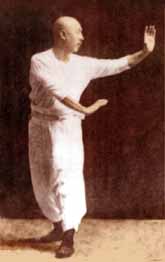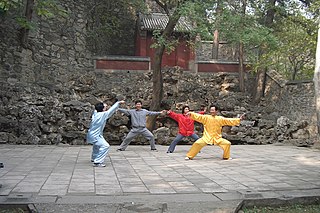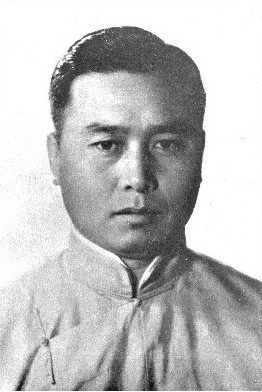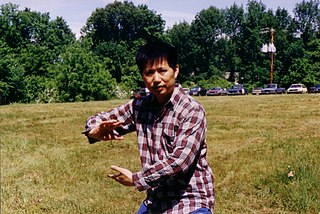Notes
This article includes a list of general references, but it lacks sufficient corresponding inline citations .(April 2015) |
- William C. C. Chen (1985). Body Mechanics of Tai Chi Chuan: For the Art of Self-defense. William C.C. Chen.
| William Chi-Cheng Chen | |
|---|---|
| Born | 1933 (age 90–91) Zhejiang, China |
| Style | Yang-style tai chi |
| Website | William C.C. Chen Tai Chi Chuan |
William Chi-Cheng Chen is a Grandmaster of Yang-style tai chi who currently lives in the US. His school is in New York City and he has hundreds of students around the world.
He was born in 1933 in Wenzhou, Zhejiang province, China. A US Passport error has his year of birth as 1935. After his family moved to Taiwan, he began studying tai chi under the tutelage of Prof. Cheng Man-ch'ing who was a childhood friend of William C. C. Chen's father.
His skill, aptitude and language skills helped him become one of Prof. Cheng Man-ch'ing's favorite disciples. Not only was he an extraordinary student but he also helped as his teachers' translator. Through this he acquired a lot of knowledge from his teacher and insight from fellow students.
This article includes a list of general references, but it lacks sufficient corresponding inline citations .(April 2015) |

Tai chi is an internal Chinese martial art practiced for self-defense and health. Known for its slow, intentional movements, tai chi has practitioners worldwide and is particularly popular as a form of gentle exercise and moving meditation, with benefits to mental and physical health.

Cheng Man-ch'ing or Zheng Manqing was a Chinese expert of tai chi, Chinese medicine, and the so-called three perfections: calligraphy, painting and poetry. He was born in Yongjia, Zhejiang Province, during the Qing dynasty. Cheng died March 26, 1975; his grave is near the city of Taipei in Taiwan.

Baguazhang is one of the three main Chinese martial arts of the Wudang school, the other two being tai chi and xingyiquan. It is more broadly grouped as an internal practice. Baguazhang literally means "eight trigram palm", referring to the bagua "trigrams" of the I Ching, one of the canons of Taoism.

Yang Chengfu (1883–1936) was one of the best known teachers of Yang-style tai chi. He helped develop the art into its modern form. His students would go on to found successful martial arts schools of their own and helped spread Yang-style tai chi around the world.

Yang-style tai chi is one of the five primary families of tai chi. Including its variations, it is the most popular and widely practised style of tai chi in the world today. It is second in terms of seniority, after Chen-style tai chi.

The Chen-style tai chi is a Northern Chinese martial art and the original form of tai chi. Chen-style is characterized by silk reeling, alternating fast and slow motions, and bursts of power.
Huang Sheng-shyan or Huang Xingxian was a Chinese martial artist. He was a practitioner and promoter of the art of tai chi.
Tchoung Ta-tchen or Zhong Dazhen was a martial arts teacher who developed his own version of Yang-style tai chi. He died on February 22, 2000.

Chen Qingping or Ch'en Ch'ing-p'ing (1795–1868) was a 15th generation descendant and 7th generation master of the Chen family. He is also claimed to be the 7th generation successor of the Zhaobao style of tai chi. Alternatively, many Zhaobao lineages treat him as the progenitor of tai chi in Zhaobao. He was an influential martial artist and teacher of tai chi.
Scott M. Rodell is a martial artist, author, and teacher of Yang-style taijiquan. He is the founding director of Great River Taoist Center, a non-profit organization based in Washington, D.C.
Chen Weiming (1881–1958) was a scholar, tai chi teacher, and author. He was also known by his name Chen Zengze (陳曾則), Weiming being his hao, a pen-name.

Robert William Smith was an American martial artist and writer, most noted for his prodigious output of books and articles about the Asian martial arts and their masters. Smith's writing was an important factor in the spread of Asian martial arts such as judo, baguazhang, xingyiquan, and tai chi in the postwar United States.
Stephan Berwick is an American author, martial artist, and actor known for his scholarly research on traditional Chinese martial arts – particularly Chen-style taijiquan, and roles in early Yuen Wo-ping Hong Kong Action films.

Guang Ping Yang tai chi is a tai chi style descended from Yang-style tai chi. It claims to combine all the positive aspects of Yang-style with qualities that added strength and versatility. It's stances are lower and wider than Yang-style, but not as pronounced as Chen-style. Guang Ping is also distinguished by as little as a 51%/49% weight difference between leading and trailing foot in certain moves. A stronger, more balanced foundation gives the student more power and greater flexibility. Guang Ping Yang tai chi also combines Xingyiquan and Baguazhang energies, which can be seen in Guang Ping's spiral force energy and projecting force energy theories. It has become known as the "lost" Yang-style tai chi form.

Wudangquan is a class of Chinese martial arts. In contemporary China, Chinese martial arts styles are generally classified into two major groups: Wudang (Wutang), named after the Wudang Mountains; and Shaolin, named after the Shaolin Monastery. Whereas Shaolin includes many martial art styles, Wudangquan includes only a few arts that use the focused mind to control the body. This typically encompasses tai chi, xingyiquan and baguazhang, but must also include bajiquan and Wudang Sword. Although the name Wudang distinguishes the skills, theories and applications of the internal arts from those of the Shaolin styles, these arts did not originate in the Wudang Mountains: the name Wudang comes from a popular Chinese legend that purports the genesis of tai chi and Wudang Sword by an immortal, Taoist hermit named Zhang Sanfeng who lived in the monasteries of Wudang Mountain. Wudang quan is often used synonymously with Neijia, but Neijia is a broader term that also encompasses Aikido and Qigong, which are not Wudang quan.

Yang Luchan, also known as Yang Fukui (1799–1872), was an influential Chinese practitioner and teacher of the internal style tai chi. He is known as the founder of Yang-style tai chi, the most popular and widely practised tai chi style in the world today.

Dong Huling was a master of tai chi, known for teaching Yang style and Dong style, and an early leader in the spread of tai chi worldwide. Born in Ren County, Hebei, China, his father Dong Yingjie was a top disciple of Yang Chengfu and famous for his fighting skills. Also highly skilled and creative himself, Dong Huling taught in mainland China, Hong Kong, Macau, Southeast Asia, North America, and Europe. He then emigrated to Hawaii, founding a school in Honolulu, continued teaching workshops around the world, and carried on the Dong family legacy.
Yun Mu Kwan was one of the original five "kwans" that arose in Korea following World War II. It was the name of the place where a generic form of Japanese karate (Shotokan) was being taught by a number of Korean students who had studied in Japan and returned to Korea in the first half of the twentieth century, bringing the Japanese art with them. Yun Mu Kwan, as a style, would eventually be renamed Jidokwan by various former students and would become one of the core styles that contributed to the development of what is today known as Taekwondo.

Zhang Luping was a Chinese martial artist and mathematician born in Jiaxing, Zhejiang province. He was best known in China for his exceptional skill at tai chi's push hands, and for an incident in his hometown in which he accidentally broke a weightlifting champion’s forearm during an arm wrestling match. He was a student of Cai Hong Xiang (蔡鸿祥), Wang Zi-Ping, and Xie Bingcan. He was also a descendant of Zhang Jun and of Zhang Jiugao (張九皋), who was the brother of Zhang Jiuling. He was noted for his deep knowledge of the five styles of tai chi, his superb application of the principles, and his highly developed internal power. In an age when many great martial arts teachers remained reluctant to share their highest insights and techniques, Zhang championed in his teaching an attitude of openness and a strong desire to ensure the continuation of Chinese martial traditions.
Benjamin Pang Jeng Lo was proponent of tai chi in the United States. Lo was a student of Cheng Man-ch'ing, translated several influential tai chi books into English, and was a teacher in his own right.